-
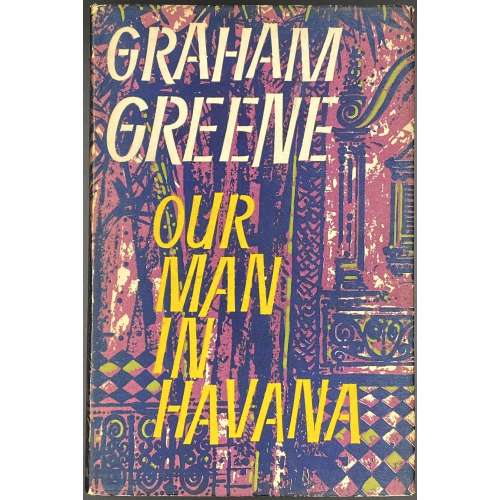 Title page: GRAHAM GREENE | {double rule} | Our Man in Havana | AN ENTERTAINMENT | {publisher’s device: windmill among the hills, letters W and H} | HEINEMANN | LONDON MELBOURNE TORONTO || Title verso: William Heinemann Ltd | LONDON MELBOURNE TORONTO | CAPE TOWN AUCKLAND | THE HAGUE | First published 1958 | © by William Heinemann Limited 1958 | All rights reserved | Printed in Great Britain | at The Windmill Press | Kingswood, Surrey || Pagination: [6] [1, 2] 3-273 [274]. Binding: 20.2 x 13.5 cm, publisher’s blue cloth, gilt lettering to spine (top): OUR | MAN | IN | HAVANA | {double rule} | GRAHAM GREENE | (bottom): HEINEMANN ||; blind-stamped publisher’s device to back cover in the lower-right corner without lettering; pp. 1-122 and 253-274 darker, than the middle pages; original dust jacket designed by Donald Green, unclipped, 15s NET in the lower-right corner of the front flap, advertisement of The quiet American on the back. Edition: 1st edition, 1st printing. Contributors: Graham Greene (British, 1904 – 1991) – author. Donald Green (British, 1919 – 1983) – DJ artist. William Henry Heinemann (British-Jewish, 1863 – 1920); William Heinemann Limited – publisher. The Windmill Press (Kingswood, Surrey) – printer.
Title page: GRAHAM GREENE | {double rule} | Our Man in Havana | AN ENTERTAINMENT | {publisher’s device: windmill among the hills, letters W and H} | HEINEMANN | LONDON MELBOURNE TORONTO || Title verso: William Heinemann Ltd | LONDON MELBOURNE TORONTO | CAPE TOWN AUCKLAND | THE HAGUE | First published 1958 | © by William Heinemann Limited 1958 | All rights reserved | Printed in Great Britain | at The Windmill Press | Kingswood, Surrey || Pagination: [6] [1, 2] 3-273 [274]. Binding: 20.2 x 13.5 cm, publisher’s blue cloth, gilt lettering to spine (top): OUR | MAN | IN | HAVANA | {double rule} | GRAHAM GREENE | (bottom): HEINEMANN ||; blind-stamped publisher’s device to back cover in the lower-right corner without lettering; pp. 1-122 and 253-274 darker, than the middle pages; original dust jacket designed by Donald Green, unclipped, 15s NET in the lower-right corner of the front flap, advertisement of The quiet American on the back. Edition: 1st edition, 1st printing. Contributors: Graham Greene (British, 1904 – 1991) – author. Donald Green (British, 1919 – 1983) – DJ artist. William Henry Heinemann (British-Jewish, 1863 – 1920); William Heinemann Limited – publisher. The Windmill Press (Kingswood, Surrey) – printer. -
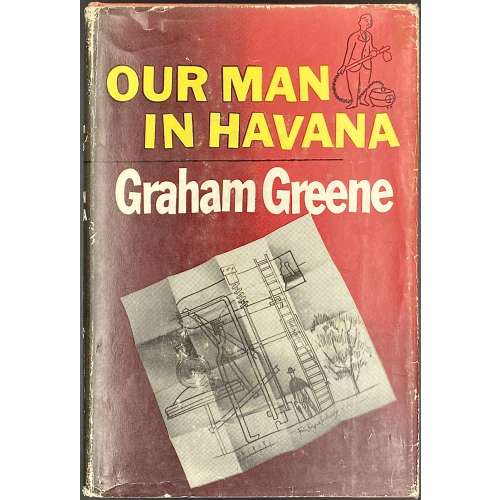 Title page: GRAHAM GREENE | {double rule} | Our Man | in Havana | AN ENTERTAINMENT | {citation: “And the sad man is cock of all his jests.” | — GEORGE HERBERT } | 1958 | THE VIKING PRESS • NEW YORK || Title verso: (top) COPYRIGHT © BY WILLIAM HEINEMANN LIMITED | PUBLISHED IN 1958 BY THE VIKING PRESS, INC. | 625 MADISON AVENUE, NEW YORK 22, N. Y. | (bottom) {publisher’s device} | LIBRARY OF CONGRESS CATALOGUE CARD NUMBER: 58.11735 | PRINTED IN THE U. S. A. BY | AMERICAN BOOK – STRATFORD PRESS || Pagination: [6] [1, 2] 3-273 [274]. Binding: 21 x 14 cm, publisher’s pink cloth, black lettering to spine: {double rule} | GRAHAM GREENE | Our | Man | in | Havana | VIKING | {double rule} ||; black vignette to front cover in the lower-right corner; original pictorial dust jacket designed by Bill English, unclipped, $3.50 in the upper-right corner of the front flap, advertisement “Also by Graham Greene” on the back flap. Edition: 1st American edition. Contributors: Henry Graham Greene (British, 1904 – 1991) – author. Bill English (British, b. 1931) – artist. The Viking Press, NY (1925 – 1975) – publisher. American Book-Stratford Press, Inc. – printer.
Title page: GRAHAM GREENE | {double rule} | Our Man | in Havana | AN ENTERTAINMENT | {citation: “And the sad man is cock of all his jests.” | — GEORGE HERBERT } | 1958 | THE VIKING PRESS • NEW YORK || Title verso: (top) COPYRIGHT © BY WILLIAM HEINEMANN LIMITED | PUBLISHED IN 1958 BY THE VIKING PRESS, INC. | 625 MADISON AVENUE, NEW YORK 22, N. Y. | (bottom) {publisher’s device} | LIBRARY OF CONGRESS CATALOGUE CARD NUMBER: 58.11735 | PRINTED IN THE U. S. A. BY | AMERICAN BOOK – STRATFORD PRESS || Pagination: [6] [1, 2] 3-273 [274]. Binding: 21 x 14 cm, publisher’s pink cloth, black lettering to spine: {double rule} | GRAHAM GREENE | Our | Man | in | Havana | VIKING | {double rule} ||; black vignette to front cover in the lower-right corner; original pictorial dust jacket designed by Bill English, unclipped, $3.50 in the upper-right corner of the front flap, advertisement “Also by Graham Greene” on the back flap. Edition: 1st American edition. Contributors: Henry Graham Greene (British, 1904 – 1991) – author. Bill English (British, b. 1931) – artist. The Viking Press, NY (1925 – 1975) – publisher. American Book-Stratford Press, Inc. – printer. -
 DJ: Graham Greene | THE COMEDIANS || Title page: THE COMEDIANS | Graham Greene | {four lines citation from Thomas Hardy} | {publisher’s device} | THE BODLEY HEAD| LONDON || Edition: 1st edition, 1st printing. Binding: bound in green cloth, 20.5 x 13.5 cm, with gilt lettering to spine, in green pictorial dust jacket with white lettering, price clipped; gift autograph to fep: “To. | Richard | From: gig | Xmas 1964.” (sic., the book was published in 1966!) Pagination: [1-4] 5-313 [314 blank] [6] blanks (total 320 pages). Collation: 16mo; [A]4 B-K16 L12 (total 160 leaves).
DJ: Graham Greene | THE COMEDIANS || Title page: THE COMEDIANS | Graham Greene | {four lines citation from Thomas Hardy} | {publisher’s device} | THE BODLEY HEAD| LONDON || Edition: 1st edition, 1st printing. Binding: bound in green cloth, 20.5 x 13.5 cm, with gilt lettering to spine, in green pictorial dust jacket with white lettering, price clipped; gift autograph to fep: “To. | Richard | From: gig | Xmas 1964.” (sic., the book was published in 1966!) Pagination: [1-4] 5-313 [314 blank] [6] blanks (total 320 pages). Collation: 16mo; [A]4 B-K16 L12 (total 160 leaves). -
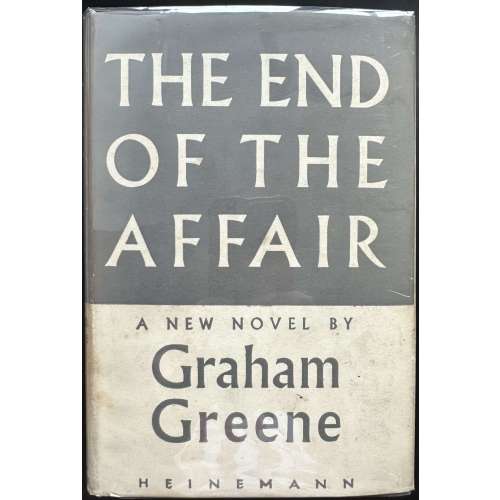 Hardcover volume, 19 x 13 cm, grey cloth with gilt lettering to spine, grey/cream dust jacket lettered throughout, price “10s 6d | NET” unclipped. Covers rubbed, dust jacket has a purple ink stain on the back bottom. Black ink inscription to recto ffl. Collation: a-o8 p10, total 122 leaves; pp.: [6] 1-237 [238]. 1st edition, 1st issue / Great Britain. Title-page: THE END OF THE | AFFAIR | by | GRAHAM GREENE | {publisher’s device} | — | WILLIAM HEINEMANN LTD | MELBOURNE :: LONDON :: TORONTO || Imprint: FIRST PUBLISHED 1951 | PRINTED IN GREAT BRITAIN | AT THE WINDMILL PRESS | KINGSWOOD, SURREY || Dedication: To C. (Catherine Walston, nee Crompton, American, 1925 – 1978) Contributors: Graham Greene (British, 1904 – 1991) William Henry Heinemann (Jewish-British, 1863 – 1920)
Hardcover volume, 19 x 13 cm, grey cloth with gilt lettering to spine, grey/cream dust jacket lettered throughout, price “10s 6d | NET” unclipped. Covers rubbed, dust jacket has a purple ink stain on the back bottom. Black ink inscription to recto ffl. Collation: a-o8 p10, total 122 leaves; pp.: [6] 1-237 [238]. 1st edition, 1st issue / Great Britain. Title-page: THE END OF THE | AFFAIR | by | GRAHAM GREENE | {publisher’s device} | — | WILLIAM HEINEMANN LTD | MELBOURNE :: LONDON :: TORONTO || Imprint: FIRST PUBLISHED 1951 | PRINTED IN GREAT BRITAIN | AT THE WINDMILL PRESS | KINGSWOOD, SURREY || Dedication: To C. (Catherine Walston, nee Crompton, American, 1925 – 1978) Contributors: Graham Greene (British, 1904 – 1991) William Henry Heinemann (Jewish-British, 1863 – 1920) -
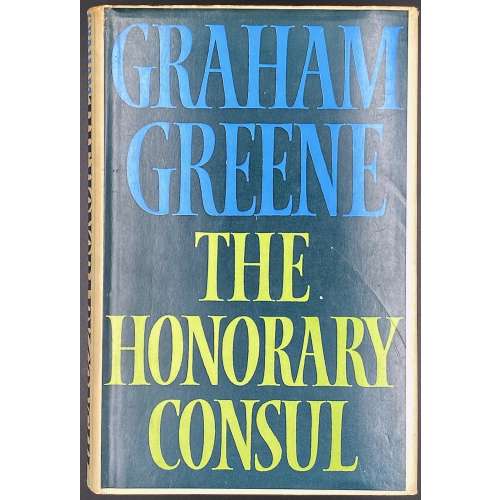 Hardcover, 20.2 x 13.6 cm, green cloth, gilt lettering to spine, in unclipped dust jacket, pp.: [1-8] 9-334 [2]. Title-page: THE HONORARY CONSUL | GRAHAM GREENE | {4 line citation} | {publisher’s device} | THE BODLEY HEAD | LONDON SYDNEY | TORONTO || © Graham Greene 1973. Printed by: William Clowes & Sons Ltd. (Beccles). Graham Greene (British, 1904 – 1991).
Hardcover, 20.2 x 13.6 cm, green cloth, gilt lettering to spine, in unclipped dust jacket, pp.: [1-8] 9-334 [2]. Title-page: THE HONORARY CONSUL | GRAHAM GREENE | {4 line citation} | {publisher’s device} | THE BODLEY HEAD | LONDON SYDNEY | TORONTO || © Graham Greene 1973. Printed by: William Clowes & Sons Ltd. (Beccles). Graham Greene (British, 1904 – 1991). -
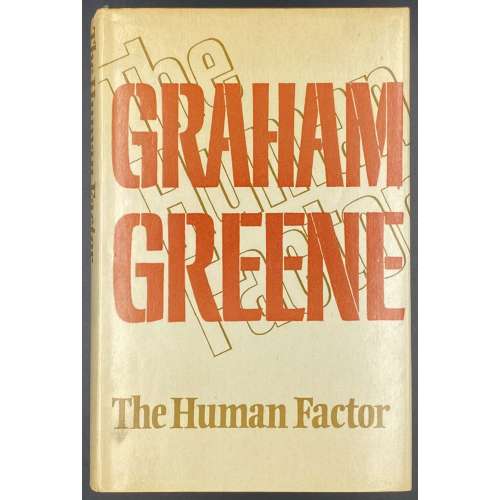 Title-page: THE HUMAN | FACTOR | Graham Greene | {citation from Joseph Conrad, 3 lines} | {publisher’s device} | THE BODLEY HEAD | LONDON SYDNEY | TORONTO || Green publisher’s cloth with gilt lettering to spine, cream dust jacket, lettered on front, back and spine, designed by Michael Harvey, unclipped (£4.50 NET | IN U.K. ONLY), [1-8] 9-338 [339] [340 blank]. Previous owners' inscriptions to FFEP. Printed by William Clowes & Sons Ltd. (Beccles). © Graham Greene 1978. Graham Greene (British, 1904 – 1991).
Title-page: THE HUMAN | FACTOR | Graham Greene | {citation from Joseph Conrad, 3 lines} | {publisher’s device} | THE BODLEY HEAD | LONDON SYDNEY | TORONTO || Green publisher’s cloth with gilt lettering to spine, cream dust jacket, lettered on front, back and spine, designed by Michael Harvey, unclipped (£4.50 NET | IN U.K. ONLY), [1-8] 9-338 [339] [340 blank]. Previous owners' inscriptions to FFEP. Printed by William Clowes & Sons Ltd. (Beccles). © Graham Greene 1978. Graham Greene (British, 1904 – 1991). -
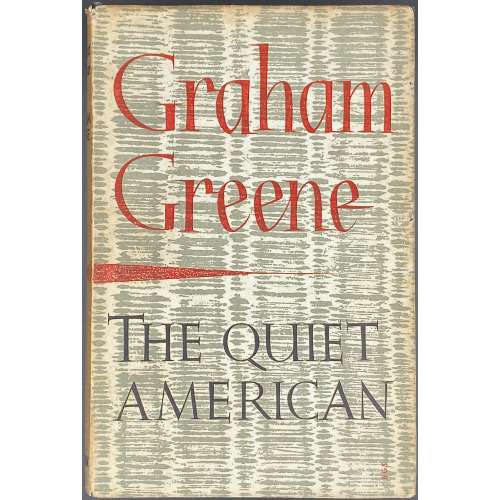 Description: 16mo, 20.2 x 13.5 cm, bound in blue buckram with gilt lettering to spine, in dust jacket lettered to front, spine, back, and flaps, price 13s6d net uncut; front has red letters “BGS” in the bottom right (probably stands for Book Grading Service); 1st edition. Title-page: THE | QUIET AMERICAN | by | GRAHAM GREENE | {publisher’s device} |—| WILLIAM HEINEMANN LTD | MELBOURNE :: LONDON :: TORONTO || T.p. verso: FIRST PUBLISHED 1955 | PRINTED IN GREAT BRITAIN | AT THE WINDMILL PRESS | KINGSWOOD, SURREY || Collation: [A]-H16; total 128 leaves. Pagination: [8] [2] 3-247 [248]; total 256 pages. Contributors: Graham Greene (British, 1904 – 1991) William Henry Heinemann (Jewish-British, 1863 – 1920)
Description: 16mo, 20.2 x 13.5 cm, bound in blue buckram with gilt lettering to spine, in dust jacket lettered to front, spine, back, and flaps, price 13s6d net uncut; front has red letters “BGS” in the bottom right (probably stands for Book Grading Service); 1st edition. Title-page: THE | QUIET AMERICAN | by | GRAHAM GREENE | {publisher’s device} |—| WILLIAM HEINEMANN LTD | MELBOURNE :: LONDON :: TORONTO || T.p. verso: FIRST PUBLISHED 1955 | PRINTED IN GREAT BRITAIN | AT THE WINDMILL PRESS | KINGSWOOD, SURREY || Collation: [A]-H16; total 128 leaves. Pagination: [8] [2] 3-247 [248]; total 256 pages. Contributors: Graham Greene (British, 1904 – 1991) William Henry Heinemann (Jewish-British, 1863 – 1920) -
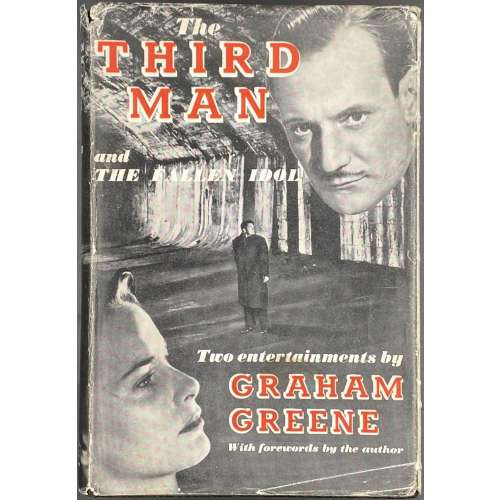 Title page: THE THIRD MAN | and | THE FALLEN IDOL | by | GRAHAM GREENE | {publisher’s device with lettering} |WILLIAM HEINEMANN LTD | MELBOURNE : : LONDON : : TORONTO || Title verso: FIRST PUBLISHED 1950 | PRINTED IN GREAT BRITAIN | AT THE WINDMILL PRESS | KINGSWOOD, SURREY || Pagination:[6] [1, 2] 3-188 [2] blank. Binding: publisher’s black cloth, silver lettering to spine, blind-stamped publisher’s device to back cover in the lower-right corner without lettering; publisher's pictorial dust jacket with lettering (white and read on b/w photo): The | THIRD | MAN | and | THE FALLEN IDOL | The entertainments by | GRAHAM | GREENE | With forewords by the author ||, price clipped. Size: 19 x 13 cm. Edition: 1st edition, 1st printing. Contributors: Graham Greene (British, 1904 – 1991) – author. William Henry Heinemann (British-Jewish, 1863 – 1920); William Heinemann Limited – publisher. The Windmill Press (Kingswood, Surrey) – printer.
Title page: THE THIRD MAN | and | THE FALLEN IDOL | by | GRAHAM GREENE | {publisher’s device with lettering} |WILLIAM HEINEMANN LTD | MELBOURNE : : LONDON : : TORONTO || Title verso: FIRST PUBLISHED 1950 | PRINTED IN GREAT BRITAIN | AT THE WINDMILL PRESS | KINGSWOOD, SURREY || Pagination:[6] [1, 2] 3-188 [2] blank. Binding: publisher’s black cloth, silver lettering to spine, blind-stamped publisher’s device to back cover in the lower-right corner without lettering; publisher's pictorial dust jacket with lettering (white and read on b/w photo): The | THIRD | MAN | and | THE FALLEN IDOL | The entertainments by | GRAHAM | GREENE | With forewords by the author ||, price clipped. Size: 19 x 13 cm. Edition: 1st edition, 1st printing. Contributors: Graham Greene (British, 1904 – 1991) – author. William Henry Heinemann (British-Jewish, 1863 – 1920); William Heinemann Limited – publisher. The Windmill Press (Kingswood, Surrey) – printer. -
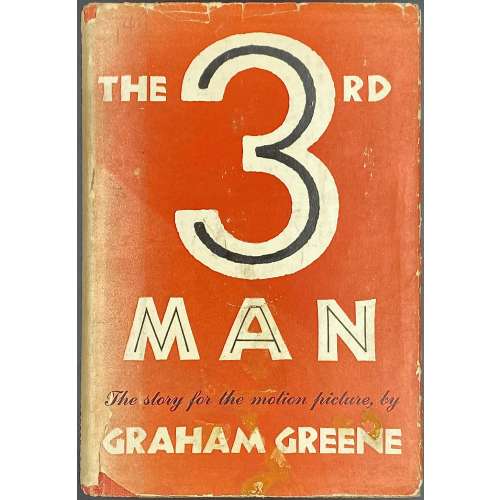 Title page: GRAHAM | GREENE | {vignette} | THE | THIRD MAN | NEW YORK • THE VIKING PRESS • 1950 || Title verso: COPYRIGHT 1949, 1950 BY GRAHAM GREENE | PUBLISHED BY THE VIKING PRESS IN MARCH 1950 | PUBLISHED ON THE SAME DAY IN THE DOMINION OF CANADA | BY THE MACMILLAN COMPANY OF CANADA LIMITED | A condensed version appeared | in The American Magazine, | {publisher’s device} | PRINTED IN U.S.A. BY THE COLONIAL PRESS INC. || Pagination: [1-6] 7-157 [158] [2] blank. Binding: quarter red cloth over grey cloth boards with black lettering to spine, pictorial dust jacket with lettering to front, back and spine, unclipped, $2.00 in the upper-right corner of the front flap. Size:19.5 x 13.5 cm. Edition: 1st American edition. Contributors: Henry Graham Greene (British, 1904 – 1991) – author. The Viking Press, NY (1925 – 1975) – publisher. The Colonial Press, Inc – printer.
Title page: GRAHAM | GREENE | {vignette} | THE | THIRD MAN | NEW YORK • THE VIKING PRESS • 1950 || Title verso: COPYRIGHT 1949, 1950 BY GRAHAM GREENE | PUBLISHED BY THE VIKING PRESS IN MARCH 1950 | PUBLISHED ON THE SAME DAY IN THE DOMINION OF CANADA | BY THE MACMILLAN COMPANY OF CANADA LIMITED | A condensed version appeared | in The American Magazine, | {publisher’s device} | PRINTED IN U.S.A. BY THE COLONIAL PRESS INC. || Pagination: [1-6] 7-157 [158] [2] blank. Binding: quarter red cloth over grey cloth boards with black lettering to spine, pictorial dust jacket with lettering to front, back and spine, unclipped, $2.00 in the upper-right corner of the front flap. Size:19.5 x 13.5 cm. Edition: 1st American edition. Contributors: Henry Graham Greene (British, 1904 – 1991) – author. The Viking Press, NY (1925 – 1975) – publisher. The Colonial Press, Inc – printer. -
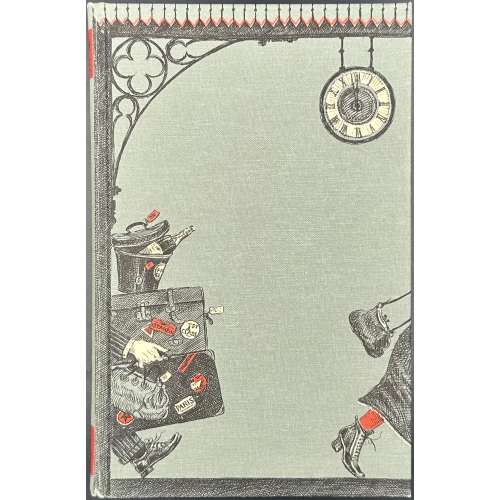 Hardcover volume, 23 x 15 cm, bound in full pictorial olive cloth, lettering to spine, in a green slipcase 23.5 x 15.9 cm; pp.: [1-4] 5- 267 [268] [4 blanks], b/w tailpieces, frontispiece and 8 colour photomechanical plates after John Holder. Title-page: GRAHAM GREENE | TRAVELS WITH MY AUNT | A Novel | Introduced by John Mortimer | Illustrated by John Holder | FOLIO SOCIETY | LONDON MMIV || Contributors: Graham Greene (British, 1904 – 1991) – author. John Mortimer (British, 1923 – 2009) – author/introduction. John Holder (British, b. 1941) – artist. St. Edmundsbury Press (UK) – printer. Hunter & Fouls (Haddington) – binder. Folio Society (UK) – publisher. For the 1st edition, see [LIB-2758.2021] Graham Greene. Travels with my aunt: a novel. — London: Bodley Head, 1969.
Hardcover volume, 23 x 15 cm, bound in full pictorial olive cloth, lettering to spine, in a green slipcase 23.5 x 15.9 cm; pp.: [1-4] 5- 267 [268] [4 blanks], b/w tailpieces, frontispiece and 8 colour photomechanical plates after John Holder. Title-page: GRAHAM GREENE | TRAVELS WITH MY AUNT | A Novel | Introduced by John Mortimer | Illustrated by John Holder | FOLIO SOCIETY | LONDON MMIV || Contributors: Graham Greene (British, 1904 – 1991) – author. John Mortimer (British, 1923 – 2009) – author/introduction. John Holder (British, b. 1941) – artist. St. Edmundsbury Press (UK) – printer. Hunter & Fouls (Haddington) – binder. Folio Society (UK) – publisher. For the 1st edition, see [LIB-2758.2021] Graham Greene. Travels with my aunt: a novel. — London: Bodley Head, 1969. -
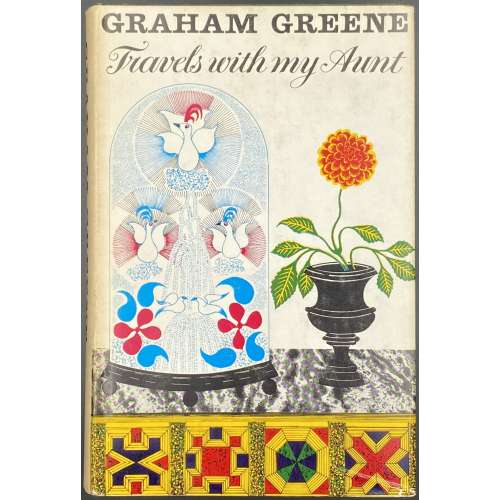 DJ: Graham Greene | Travels with my aunt || Title page: TRAVELS | WITH MY AUNT | A NOVEL | Graham Greene |{publisher’s device}| THE BODLEY HEAD | LONDON SYDNEY | TORONTO || Edition: 1st edition, 1st printing. Binding: 20.5 x 13.5 cm; publisher's green cloth, gilt lettering on spine, pictorial dust-jacket. Pagination: [1-8] 9 – 319 [320]. Collation: 16mo; [1]16, 2-1016 (total 160 leaves). Contributors: Graham Greene (British, 1904 – 1991) – author. Stephen Russ (British, 1919 – 1983) – DJ artist. The Bodley Head – publisher. William Clowes & Sons, Ltd. (Beccles) – printer.
DJ: Graham Greene | Travels with my aunt || Title page: TRAVELS | WITH MY AUNT | A NOVEL | Graham Greene |{publisher’s device}| THE BODLEY HEAD | LONDON SYDNEY | TORONTO || Edition: 1st edition, 1st printing. Binding: 20.5 x 13.5 cm; publisher's green cloth, gilt lettering on spine, pictorial dust-jacket. Pagination: [1-8] 9 – 319 [320]. Collation: 16mo; [1]16, 2-1016 (total 160 leaves). Contributors: Graham Greene (British, 1904 – 1991) – author. Stephen Russ (British, 1919 – 1983) – DJ artist. The Bodley Head – publisher. William Clowes & Sons, Ltd. (Beccles) – printer. -
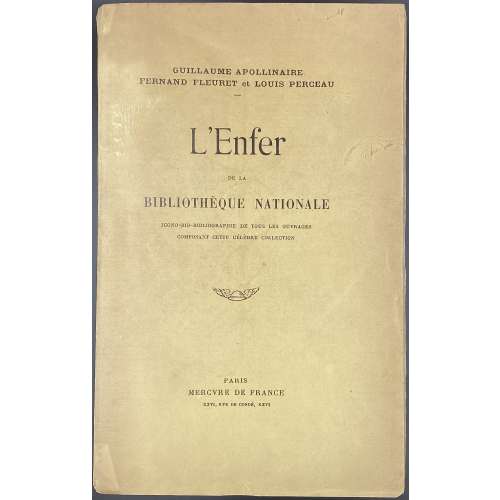 Title: GUILLAUME APOLLINAIRE | FERNAND FLEURET LOUIS PERCEAU | L'Enfer | DE LA | BIBLIOTHÈQUE NATIONALE | ICONO-BIO-BIBLIOGRAPHIE | DESCRIPTIVE, CRITIQUE ET RAISONNÉE, | COMPLÈTE A CE JOUR | DE TOUS LES OUVRAGES COMPOSANT CETTE CÉLÈBRE COLLECTION | AVEC UN INDEX ALPHABÉTIQUE | DES TITRES ET NOMS D'AUTEURS | PARIS | MERCVRE DE FRANCE | XXVI, RVE DE CONDÉ, XXVI | MCMXII || Pagination: ffl, [1-5] 6-415 [416], bfl. Collation: [1]8 2-268. Binding: Original tan wrappers, lettering to covers and spine. Edition: First edition of which this is №952. Ref.: BnF
Title: GUILLAUME APOLLINAIRE | FERNAND FLEURET LOUIS PERCEAU | L'Enfer | DE LA | BIBLIOTHÈQUE NATIONALE | ICONO-BIO-BIBLIOGRAPHIE | DESCRIPTIVE, CRITIQUE ET RAISONNÉE, | COMPLÈTE A CE JOUR | DE TOUS LES OUVRAGES COMPOSANT CETTE CÉLÈBRE COLLECTION | AVEC UN INDEX ALPHABÉTIQUE | DES TITRES ET NOMS D'AUTEURS | PARIS | MERCVRE DE FRANCE | XXVI, RVE DE CONDÉ, XXVI | MCMXII || Pagination: ffl, [1-5] 6-415 [416], bfl. Collation: [1]8 2-268. Binding: Original tan wrappers, lettering to covers and spine. Edition: First edition of which this is №952. Ref.: BnF -
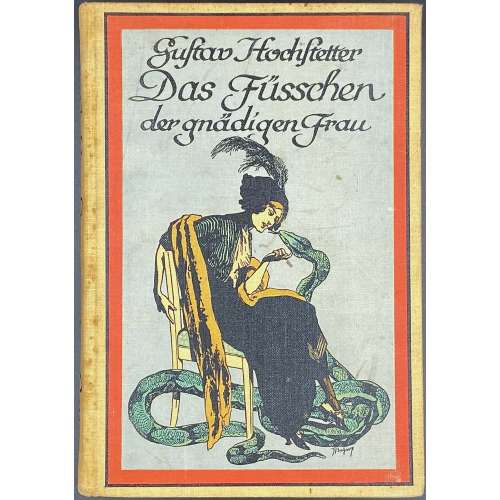 Description: Hardcover, 18.8 x 13 cm, pictorial front cover (after Franz von Bayros) in colour over tan cloth, lettering to spine, all margins red, laid paper endpapers, pp.: [4] 1-185 [3]; collated 8vo as π2 1-118, 126, total 192 pages (96 leaves) plus 5 b/w photogravures after drawings by Franz von Bayros. Title-page (blackletter): Gustav Hochstetter | Das Füsschen der gnädigen Frau | und Anderes | {publisher’s device} | {blank} | 1912 | München und Leipzig bei Georg Müller || T.p. verso (blackletter): Umschlagzeichnung und fünf Bildbeigeben von | Franz von Bayros | {blank} | (serif) Copyright 1912 by Georg Müller in München || Colophon: Druck von Mänicke u. Jahn, Rudolstadt. Contributors: Gustav Hochstetter (German-Jewish, 1873 – 1944) – author. Franz von Bayros (Austrian, 1866 – 1924) – artist. Mänicke und Jahn (Rudolstadt) – printer. Georg Müller (München, Leipzig) – publisher.
Description: Hardcover, 18.8 x 13 cm, pictorial front cover (after Franz von Bayros) in colour over tan cloth, lettering to spine, all margins red, laid paper endpapers, pp.: [4] 1-185 [3]; collated 8vo as π2 1-118, 126, total 192 pages (96 leaves) plus 5 b/w photogravures after drawings by Franz von Bayros. Title-page (blackletter): Gustav Hochstetter | Das Füsschen der gnädigen Frau | und Anderes | {publisher’s device} | {blank} | 1912 | München und Leipzig bei Georg Müller || T.p. verso (blackletter): Umschlagzeichnung und fünf Bildbeigeben von | Franz von Bayros | {blank} | (serif) Copyright 1912 by Georg Müller in München || Colophon: Druck von Mänicke u. Jahn, Rudolstadt. Contributors: Gustav Hochstetter (German-Jewish, 1873 – 1944) – author. Franz von Bayros (Austrian, 1866 – 1924) – artist. Mänicke und Jahn (Rudolstadt) – printer. Georg Müller (München, Leipzig) – publisher. -
 Gustave Macé. La Police parisienne. Le vilain monde. Les dépeceurs de cadavres. Gibier de Saint-Lazare — Paris: Librairie illustrée, [1889]. Title-page: LA | POLICE PARISIENNE |—| LE VILAIN MONDE |—| LES DEPECEURS DE CADAVRES |—| GIBIER DE SAINT-LAZARE |—| Par | G. MACE | ANCIEN CHEF DE LA POLICE DE SURETÉ | {publisher’s device} | PARIS | LIBRAIRIE ILLUSTRÉE | 8, RUE SAINT-JOSEPH, 8 || Description: Hardcover, 4to, 28 x 20 cm, quarter green calf over green marbled boards, raised bands, gilt lettering and gilt fillets to spine, marbled endpapers. Collation:1st bank, [π2 h.t., t.p.], [1]-1074 [108]2 table, last blank; total 432 leaves; 107 woodcuts by Puyplat after E. Mas (on the recto of the first leaf of each complete gathering). Pagination: [4] [1-3] 4-859 [860]; total 864 pp. Edition: Later edition, probably 1889; the 1st edition was published in 1885. Contributors: Gustave Macé (French, 1835 – 1904) – author. Émile Mas (French, 1866 – 1950) – artist. Jules Jacques Puyplat (French, fl. c. 1877 – 1893) – engraver.
Gustave Macé. La Police parisienne. Le vilain monde. Les dépeceurs de cadavres. Gibier de Saint-Lazare — Paris: Librairie illustrée, [1889]. Title-page: LA | POLICE PARISIENNE |—| LE VILAIN MONDE |—| LES DEPECEURS DE CADAVRES |—| GIBIER DE SAINT-LAZARE |—| Par | G. MACE | ANCIEN CHEF DE LA POLICE DE SURETÉ | {publisher’s device} | PARIS | LIBRAIRIE ILLUSTRÉE | 8, RUE SAINT-JOSEPH, 8 || Description: Hardcover, 4to, 28 x 20 cm, quarter green calf over green marbled boards, raised bands, gilt lettering and gilt fillets to spine, marbled endpapers. Collation:1st bank, [π2 h.t., t.p.], [1]-1074 [108]2 table, last blank; total 432 leaves; 107 woodcuts by Puyplat after E. Mas (on the recto of the first leaf of each complete gathering). Pagination: [4] [1-3] 4-859 [860]; total 864 pp. Edition: Later edition, probably 1889; the 1st edition was published in 1885. Contributors: Gustave Macé (French, 1835 – 1904) – author. Émile Mas (French, 1866 – 1950) – artist. Jules Jacques Puyplat (French, fl. c. 1877 – 1893) – engraver. -
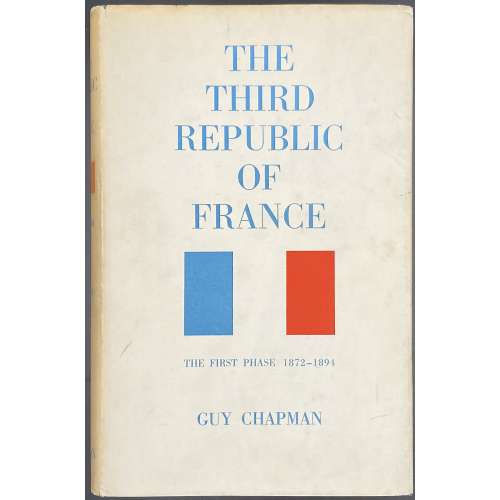 Title: THE | THIRD REPUBLIC | OF FRANCE | THE FIRST PHASE 1871–1894 | BY | GUY CHAPMAN | Sometime Professor of Modern History in the University of Leeds | LONDON | MACMILLAN & CO LTD | NEW YORK • ST. MARTIN’S PRESS | 1962 Pagination: [i-iv] v-xxii, [1] 2-433 [434 imprint]. Collation: 8vo; [A]8 B-Z8 2A-2D8 2E2 2E210. Binding: blue buckram, bronze lettering to spine, pictorial DJ. Publishing year 1963 according to worldcat. Author: Chapman, Guy Patterson (British, 1889 – 1972)
Title: THE | THIRD REPUBLIC | OF FRANCE | THE FIRST PHASE 1871–1894 | BY | GUY CHAPMAN | Sometime Professor of Modern History in the University of Leeds | LONDON | MACMILLAN & CO LTD | NEW YORK • ST. MARTIN’S PRESS | 1962 Pagination: [i-iv] v-xxii, [1] 2-433 [434 imprint]. Collation: 8vo; [A]8 B-Z8 2A-2D8 2E2 2E210. Binding: blue buckram, bronze lettering to spine, pictorial DJ. Publishing year 1963 according to worldcat. Author: Chapman, Guy Patterson (British, 1889 – 1972) -
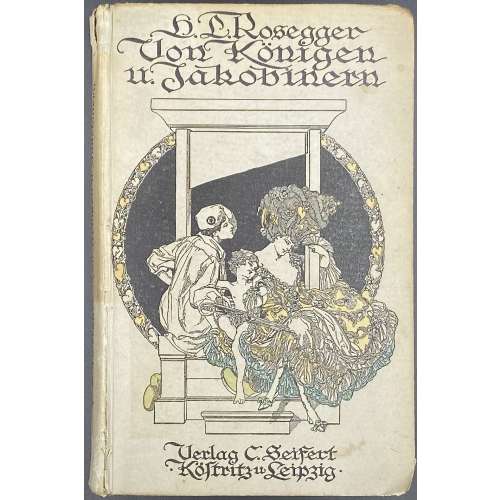 Cover (in blackletter): H. L. Rosegger. | Von Königen u. Jakobinern | {vignette by von Bayros} | Verlag C. Seifert | • Köstritz u Leipzig • || Title (blackletter): Von Königen | und Jakobinern | Von | Hans Ludwig Rosegger | mit vier Vollbildern und Buchschmuck | von Marquis F. von Bayros | {publisher’s device} | 1913 | C. Seifert Verlag, G.m.b.H. | Köstritz und Leipzig || Pagination: [2] – t.p. / blank, [2] – contents / blank, [1-3] 4-263 [264 vignette, colophon], 4 plates extraneous to collation, 2 vignettes. Collation: 8vo; 1-168 174. Binding: Hardcover, pictorial paper boards, lettering to spine, lettering and vignette by von Bayros to cover. Owner's inscription to ffl: "T. Lewe. März, 1919."
Cover (in blackletter): H. L. Rosegger. | Von Königen u. Jakobinern | {vignette by von Bayros} | Verlag C. Seifert | • Köstritz u Leipzig • || Title (blackletter): Von Königen | und Jakobinern | Von | Hans Ludwig Rosegger | mit vier Vollbildern und Buchschmuck | von Marquis F. von Bayros | {publisher’s device} | 1913 | C. Seifert Verlag, G.m.b.H. | Köstritz und Leipzig || Pagination: [2] – t.p. / blank, [2] – contents / blank, [1-3] 4-263 [264 vignette, colophon], 4 plates extraneous to collation, 2 vignettes. Collation: 8vo; 1-168 174. Binding: Hardcover, pictorial paper boards, lettering to spine, lettering and vignette by von Bayros to cover. Owner's inscription to ffl: "T. Lewe. März, 1919." -
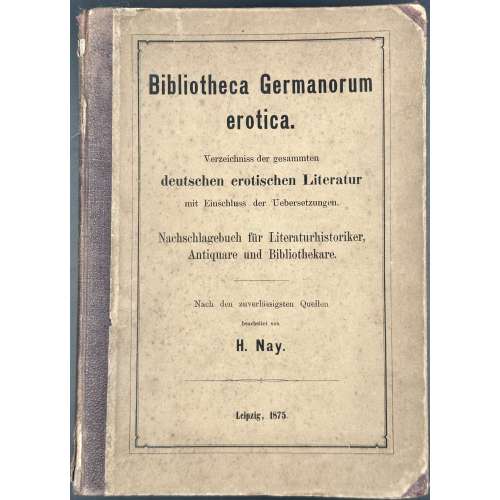 NEWHardcover, 231 x 165 mm, half brown cloth over cardboard, lettering in a frame to front, similar to t.p., pp.: [4] [1] 2-151 [152], collated 4to: π2 1-194, i.e. 78 leaves. Entries are in alphabetic order by name. Title-page (and front cover): Bibliotheca Germanorum | erotica. | Verzeichniss der gesammten | deutschen erotischen Literatur | mit Einschluss der Uebersetzungen. | Nachschlagebuch für Literaturhistoriker, | Antiquare und Bibliothekare. | Nach den zuverlässigsten Quellen | bearbeitet von | H. Nay. | — •— | Leipzig, 1875. || [Bibliotheca Germanorum erotica. List of all German erotic literature, including translations. Reference book for literary historians, antiquarians and librarians. Based on the most reliable sources edited by H. Nay]. Imprint: Druck von E. Rupfer in Stuttgart. Ref: Worldcat. Author: Hugo Hayn [Nay, H.] (German, 1843 – 1923)
NEWHardcover, 231 x 165 mm, half brown cloth over cardboard, lettering in a frame to front, similar to t.p., pp.: [4] [1] 2-151 [152], collated 4to: π2 1-194, i.e. 78 leaves. Entries are in alphabetic order by name. Title-page (and front cover): Bibliotheca Germanorum | erotica. | Verzeichniss der gesammten | deutschen erotischen Literatur | mit Einschluss der Uebersetzungen. | Nachschlagebuch für Literaturhistoriker, | Antiquare und Bibliothekare. | Nach den zuverlässigsten Quellen | bearbeitet von | H. Nay. | — •— | Leipzig, 1875. || [Bibliotheca Germanorum erotica. List of all German erotic literature, including translations. Reference book for literary historians, antiquarians and librarians. Based on the most reliable sources edited by H. Nay]. Imprint: Druck von E. Rupfer in Stuttgart. Ref: Worldcat. Author: Hugo Hayn [Nay, H.] (German, 1843 – 1923) -
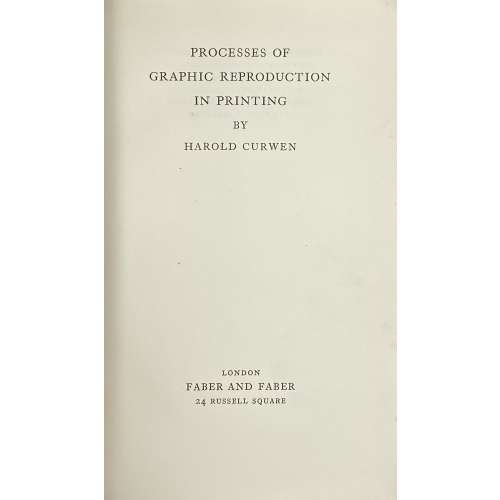 Title: PROCESSES OF | GRAPHIC REPRODUCTION | IN PRINTING | BY | HAROLD CURWEN | [space] | LONDON | FABER AND FABER | 24 RUSSELL SQUARE || Pagination: [i-vii] viii-xvi [6] [1-3] 4-142 [2], ills. Collation: 8vo; π3 [A]8 B-K8, 14 plates extraneous to collation, in-text illustrations; (quire K – 'Binding'). Binding: 22.8 x 15 cm, black cloth, gilt lettering to spine; calligraphic MS bookplate to fep "Dorothy Mahoney | 1942." Edition: 1st edition, printed by The Curwen Press in Plaistow. Contributors: Harold Curwen (British, 1885 – 1949), grandson of John Curwen (British, 1816 – 1880) – author. The Curwen Press (Plaistow, London) – printer. Faber and Faber Limited (London) – publisher. Dorothy Mahoney – provenance; author of the book The Craft Of Calligraphy, first published on October 12th, 1981 by Pelham Books. The 1st American edition was published the same year in New York by Oxford University Press [LIB-2835.2021].
Title: PROCESSES OF | GRAPHIC REPRODUCTION | IN PRINTING | BY | HAROLD CURWEN | [space] | LONDON | FABER AND FABER | 24 RUSSELL SQUARE || Pagination: [i-vii] viii-xvi [6] [1-3] 4-142 [2], ills. Collation: 8vo; π3 [A]8 B-K8, 14 plates extraneous to collation, in-text illustrations; (quire K – 'Binding'). Binding: 22.8 x 15 cm, black cloth, gilt lettering to spine; calligraphic MS bookplate to fep "Dorothy Mahoney | 1942." Edition: 1st edition, printed by The Curwen Press in Plaistow. Contributors: Harold Curwen (British, 1885 – 1949), grandson of John Curwen (British, 1816 – 1880) – author. The Curwen Press (Plaistow, London) – printer. Faber and Faber Limited (London) – publisher. Dorothy Mahoney – provenance; author of the book The Craft Of Calligraphy, first published on October 12th, 1981 by Pelham Books. The 1st American edition was published the same year in New York by Oxford University Press [LIB-2835.2021].


